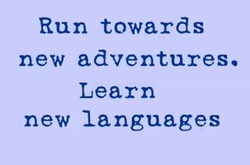Cartoon Sharing
Photograph Sharing

Don't you think those kids wearing
Chinese traditional costumes are very cute?
I think the most difficult part of
learning a foreign language is not the language itself,
but learning the culture at the same time.
Sometimes, it is just a kind of feeling.
Indulge yourself into it:
it is the hard part,
but also the fun part of learning a language.
Chinese traditional costumes are very cute?
I think the most difficult part of
learning a foreign language is not the language itself,
but learning the culture at the same time.
Sometimes, it is just a kind of feeling.
Indulge yourself into it:
it is the hard part,
but also the fun part of learning a language.
Advertisement Sharing

I choose this advertisement because it shows the benefits of learning foreign languages in a clear and funny way: more languages you learn, more fast you run. I like how it ends: "Run towards new adventures." Indeed, learning a foreign language likes running towards to an adventure, which is full of unknowns and mysteries. On the other hand, it also weaken the difficulties of actually learning a foreign language: eating a file of food, then a new language is learned. It is a good way to encourage people to start to learn a foreign language, especially for children.
Editorial Sharing http://saveourforeignlanguages.wordpress.com/2010/12/19/a-pro-foreign-language-learning-editorial/weeblylink_new_window
This editorial pointed out the special difficulties of learning foreign languages in the US. The biggest problem is that there is no supportive and inviting environment for American students to learn a foreign language and reach a certain advanced level. And it also proposed two solutions to foreign language programs in the universities.
Speech Sharing

This video is about professor Stephen Krashen to explain his famous language acquisition theory. Dr. Krashen's theory has very huge influence in field of language teaching and learning. He challenged the traditional grammar based language teaching method and proposed that language is learned in the same way, no matter native language or second language. On the good side, he encouraged teachers to focus on communication rather than grammar, which was a cure for the disadvantages of language class. However, on the bad side, many teachers over believed in Krashen's theory, thoroughly negating the values of language class and grammar teaching. There was one thing Krashen ignored. That was the differences between children and adults. During his speech, he used children as example to explain how "comprehensive input" and "low anxiety" was the only way for them to learn a language. But, how about adults? Do adults learn language in the same way? Obviously, they don't. As far as we know that, children learn languages easier and faster, because of the "language acquisition device," which Krashen mentioned in his speech. However, when people reach certain age, the LAD is not there anymore. That explains why adults learning languages is so hard. Adults need language classes to help them "learn" languages intentionally, while children can "acquire" languages through extensive exposure to those languages. Therefore, people don't learn languages in the same. Like the "digest" example Krashen used, maybe people digest food in the same way, but what they can eat is different. Children and adults eat different food, so does everyone. So the metaphor Krashen used was not appropriate.


